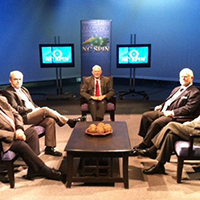In his new role Peter cannot be Hans Solo
Published May 3, 2018
By Tom Campbell
by Tom Campbell, Producer and Moderator, NC SPIN, May 2, 2018.
The selection of Peter Hans to head our state’s Community College System was expected, especially after it became known that Governor Roy Cooper, House Speaker Tim Moore and Senate President Pro Tem Phil Berger jointly wrote a letter to the selection committee making it clear Hans was their choice. Peter Hans has previously served as a state community college board member, former chair of the UNC Board of Governors and is politically well connected. He will need that experience and those relationships in his new role.
The new President faces long-standing problems with governance, funding and defining the role and improved cooperation with the state’s two other education systems – state supported universities and k-12 public schools.
The education governance structure in our state is confusing on all levels and been debated going back to when then Governor Terry Sanford was involved in the creation of community colleges. Sanford saw potential problems with mission overlap, funding priorities and the potential for turf battles between the post-high school education systems. Former State Board of Education Chair, Dallas Herring, also a champion for the creation for community colleges envisioned the need for just one governance structure for all education in our state, with himself as head of it. This concept met with immediate and negative response from Bill Friday and the board of the then three-school university system, forcing Herring, Sanford and the legislature to place community colleges under the purview of the State Board of Education.
In 1981, the current structure of a statewide board and President was established as a third, separate arm of our education system, but unlike the UNC System, that board and president has limited authority over the 58 colleges in the system. The state board consists of 21 members, ten of whom are appointed by the Governor, with four each chosen by our House and Senate. It is both a blessing and problem that each school, governed by a local board and president, has great autonomy from the state office. Whereas the UNC System President and governors can establish and enforce policies, priorities and lobby the legislature effectively for funding, our Community Colleges lack the same clout, resulting in our community colleges, the third largest such system in the nation, suffering from, among other things, inadequate funding.
Perhaps more importantly, that independence has made it difficult to better define and effectively coordinate community colleges’ role within the education structure. We’ve long felt that Sanford and Herring were right in believing the ultimate solution was to have one overall education governance structure, with an education czar, if you will, as its head, but the Rapture may occur before that happens.
UNC System President Margaret Spellings was correct in saying there is no comprehensive education plan for our state. We are one the few states that doesn’t help administrators and students in navigating from pre-k through post-secondary education. With two-thirds of all jobs requiring more than just a high school diploma this lack of coordination is frustrating, as employers can’t find workers and these workers don’t have the job skills needed.
So Peter Hans has big challenges and great opportunities in his new role as President of our community colleges. Hopefully, his past experience with community colleges, universities and politicians should serve him well.







